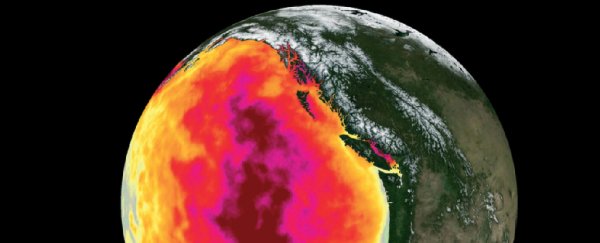'The Blob' is a nickname for a volume of water in the Pacific Ocean near the North American coast that warmed beyond typical seasonal temperatures in late 2013 – a rise that persisted for an abnormally long period of time and that devastated sea life, particularly in 2015 and 2016.
The name was inspired by the 1958 horror film The Blob, about an indiscriminate mass that consumes everything in sight.
What was 'The Blob'?
Initially measured at a size of around 800 kilometers (500 miles) across and 90 meters (300 feet) deep, by mid-2014 the patch of heated water had doubled in area, splitting into three smaller 'blobs' that stretched from Alaska down to Mexico.
Average temperatures within the waters rose around 3 degrees Celsius (5.4 degrees Fahrenheit) over a period of just a few months; a leap unseen in the history of record-keeping for that region, according to the US National Oceanic and Atmospheric Administration.
Only in 2016 did temperatures in the Pacific's coastal waters drop back to more typical fluctuations. Three years later a similar jump in temperature occurred in the same region, though it was quickly cooled by a series of storms.
 Infographic showing the rise and fall of 'The Blob'. (NOAA)
Infographic showing the rise and fall of 'The Blob'. (NOAA)
What caused The Blob's temperatures to rise?
Warmer waters in the eastern Pacific are usually created by El Niño conditions. While they were present in 2014, their relative weakness and the unique progress of temperature changes ruled El Niño out as an explanation.
Studies on the mixing of the ocean's waters in high resolution along with data on wind currents suggested a static wave of high pressure air had settled over the north Pacific some time in 2012, blocking off a river of air that normally unleashed coastal storms that helped stir the waters.
Without the typical tempests to splash up the Pacific's waters, the warm surface waters couldn't be cooled by upwellings from below, leaving a hot 'blob' of water to inch its way towards North America's coastline.
Did climate change cause The Blob?
Exactly what produced this 'ridiculously resilient ridge' is more difficult to explain, with rising temperatures in the tropical regions of the western Pacific thought to play a role.
While this (along with other evidence) implies climate change likely had a hand in its development, there's also the likelihood that random variations made it all worse. In other words, the ridge and its baby Blob might not have been so bad if not for a solid dose of bad luck.
What was the impact of The Blob?
In the years since the Blob's rise and fall, a variety of studies have identified possible impacts this sliding mass of warm water has had on ocean life.
Tens of thousands of common murres (Uria aalge) washing up on the US coast in 2015 and 2016 imply a larger than usual die-off among the seabirds. Their emaciated bodies imply starvation, suggesting a decline in availability of prey in their feeding grounds which could be the result of ocean warming.
 Common murres washed onto beaches near Homer, Alaska. (COASST/University of Washington)
Common murres washed onto beaches near Homer, Alaska. (COASST/University of Washington)
A 75 percent drop in whale births for that period might also be the result of the unusual temperatures. Warmer waters could also be responsible for expanding the timeline of whale migration routes, bringing into the path of crab fishing and putting them at risk of being snagged in fishing gear.
Will The Blob happen again?
Rising ocean temperatures in the same region in 2019 caused alarm among researchers – but fortunately, this time, storms were able to cool the region down.
However, it is clear that oceans generally are increasing in temperature as a result of climate change, and wind patterns are changing around the planet. There's also evidence that the mixing of cool and warm ocean water, known as 'stratification', is slowing down.
Whether we'll see the likes of The Blob again in the future isn't clear. But like all Hollywood horrors, it'll be a sequel nobody wants to see.
All Explainers are determined by fact checkers to be correct and relevant at the time of publishing. Text and images may be altered, removed, or added to as an editorial decision to keep information current.
